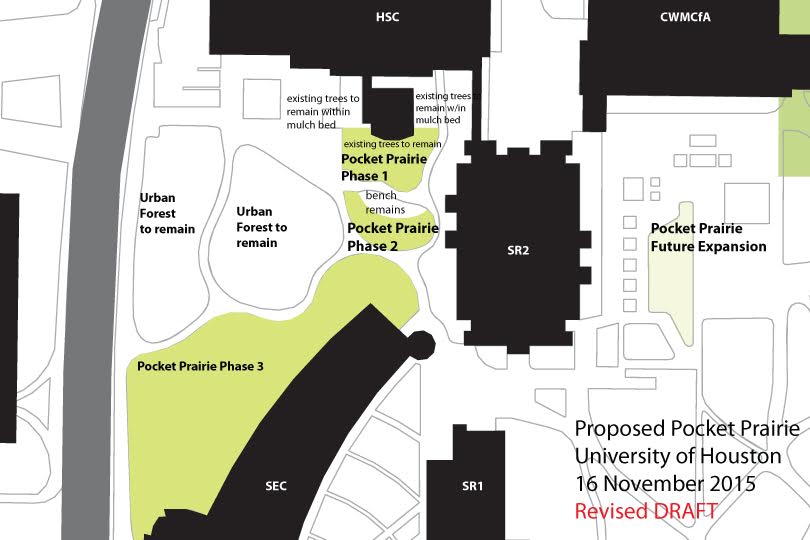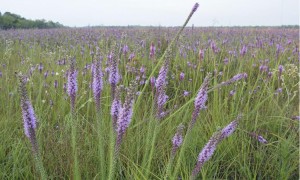

The pocket prairie will serve as a pilot project for UH. Depending on its success, it may be expanded to a few additional acres in a “phase two” project. | Courtesy of Sarah Kelly
Shasta’s home is at stake, and the community is being asked to help bring it back.
Besides the Houston Zoo, the cougar’s native habitat is the prairie, grassland that consists of large areas of tall grasses and wildflowers. Today, only one tenth of 1 percent of Texas prairies remain, UH Coastal Center Director Steven Pennings said.
“It’s a very endangered habitat, and it’s a very valuable habitat,” Pennings said. “It supports wildlife. It helps minimize flooding (and) the Houston area would be better off if we had more prairies.”
The area UH stands on today used to be solely comprised of prairie land. Now, in collaboration with the Office of Sustainability and Coastal Center, the Katy Prairie Conservancy is hoping to bring some of that history back by creating a pocket prairie on campus.
“We are not bringing something new (but) we are bringing something very ancient back to UH,” Jaime Gonzales, conservation education director for the KPC, said. “We want people to see what UH used to be.”
KPC recently launched a fundraiser to build environmental landscapes at Houston universities, including UH, Rice University and the University of St. Thomas. The fundraiser, “Grassroots for Change,” consists of a friendly social media contest between the schools that aims to raise $30,000, $10,000 for each university, to build pocket prairies that promote environmental sustainability and biodiversity.
The challenge stems from the KPC’s larger program, the Prairie Builders Schools & Parks program, which works to build pocket prairies in local K-12 schools and public parks. This is the first time that the conservancy will be engaged with university-level projects.
UH’s pocket prairie will be called the “Shasta Prairie” and will be located south of the Houston Science Center and west of the Science and Research Building 2. Aside from biodiversity protection and supporting native wildlife, the prairie will help promote the UH Coastal Center in La Marque, Texas.
“The UH Coastal Center is one of the premier biological places in the whole greater Houston area, and a lot of people don’t know about it,” Gonzales said. “So one thing we are going to do is draw attention to the UH Coastal Center by having a small chunk of it, in a sense, on campus.”
The pocket prairie will also be used as a living lab for students enrolled in ecology and biology courses.
“One of the problems we have with doing any sort of ecology course is that when we want to have a hands-on activity, you have to go some distance from campus,” Pennings said. “I teach ecology and biodiversity, and when I take my students outside it’s all a pretty unnatural environment. So I think having something that is a lot more realistic, that is a natural environment, will be a great teaching aid.”
The pocket prairie will serve as a pilot project for UH. Depending on its success, it may be expanded to a few additional acres in a “phase two” project.
“Our hope for Shasta’s Prairie is to educate the campus and community about the importance of restoring and conserving native habitats,” manager for the Office of Sustainability Sarah Kelly said. “The area will also allow campus members and visitors to reflect and connect with our natural history.”
The social media challenge will run until April 22. On April 23, also known as Earth Day, volunteers from the KPC, Office of Sustainability, Coastal Center and hopefully other local universities will come together to plant the prairie. Gonzales stressed that the challenge is intended to unite students in their efforts to promote sustainability.
“I think one of the best things about this challenge is (that) we will get students from different universities to help each other put in their pocket prairies,” Gonzales said. “We really are going to encourage the students to help one another because we have one shared planet.”
One of the main goals of the Shasta prairie is to provide a habitat for monarch butterflies, which are an endangered species.
“There will be a lot of monarch visitors to this little prairie because it will be the best place on campus to find nectar-rich plants,” Gonzales said. “It’s going to be a very alive place where people can take in the beauty of nature.”

The UH Coastal Center is home to 300 acres of threatened coastal tallgrass prairie and about 700 acres of forest. | Courtesy of Steven Pennings, director for the UH Coastal Center.
While Gonzales admits that as a double alum he does bleed Cougar red, he is staying neutral in terms of which university will raise the funds the fastest.
“We are really trying for everyone to win,” Gonzales said. “(But we also hope to) raise awareness that local wildlife need places to be, and we don’t need them in the countryside — we can have them in our communities and even on our school campuses.”
news@thedailycougar.com
—
“Contest challenges universities to recreate prairies” was originally posted on The Daily Cougar
